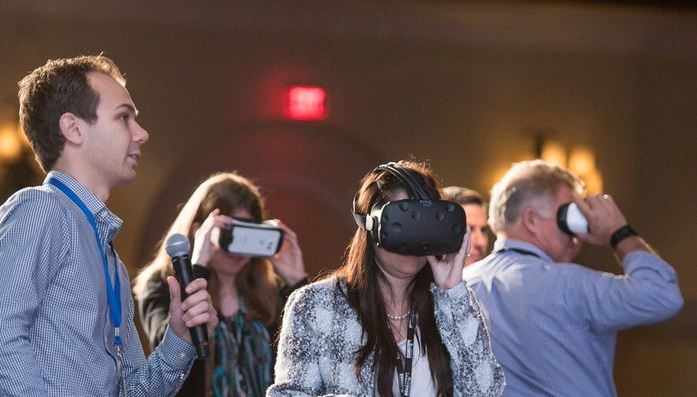Multifamily marketers from across the country converged in Huntington Beach for the 2017 Apartment Internet Marketing (AIM) Conference on May 7-10. Several hundred professionals gathered to explore the industry’s latest marketing trends and best practices. Here are three ideas from this year’s event that might buoy your marketing efforts: Tell Your Story Marketing is not just an exercise in generating the lowest cost per lead. It’s a complex combination of creativity and strategy that ultimately tells a story to potential customers. In a world of constant digital distraction, today’s marketers need to have the skills to create content that will rise above the noise. When it comes to creating engaging content, authentic storytelling and video rule. AIM panelists Jamie Matusek, President of Catalyst, Lori Valenti Webb, Director of Marketing at Wood Residential Services, and Anna Geary, Founder of Show My Property TV, explored the ideal customer experience. Matusek explained that experiences progress through the Happiness Halo framework, from anticipation to interaction to afterglow. Anticipation is the process of building excitement, teasing potential customers into wanting to know more. This can be seen in pre-event promotion and behind-the-scenes videos. Interaction immerses customers in an experience, providing emotional direction to aid in decision making. Multifamily application could be a time-constrained promotion, such as a rent discount, or highlighting property perks, such as free recreation classes or dog-friendly happy hours. Afterglow focuses on creating a positive memory, reinforcing brand positivity. As Matusek explained, bad things will happen, such as a poorly executed maintenance request or a negative front office visit, so it’s important to positively direct the sentiments with each resident touch point. Crafting an effective story can combine these three concepts into any medium, from a blog or social media post to a video. At AIM, video was...
AIM Insights
2016 Marketing Conference
Huntington Beach, Calif. — With the multifamily industry still enjoying rising rents and high occupancy rates in most markets, it’s no wonder this year’s Apartment Internet Marketing Conference had an air of successful complacency, as most apartment marketers have been enjoying smooth sailing lately. That doesn’t mean there isn’t room for improvement, and several hundred industry insiders gathered in Southern California May 2-4 to dig into the trendiest best practices for multifamily marketing. Here are a few key takeaways from the event: Smart apartments: still simmering Despite growing chatter about smart home technology, the sector hasn’t optimized for multifamily yet, but stay tuned, because development for the market is hot. “You don’t want to take something that’s created for single family homes and apply it to a 800 unit apartment complex … it won’t scale,” said Felicite Moorman, CEO of StratIS, a tech company focused on access, energy, and automation. Multifamily owners and managers were urged to focus on useful innovations first, before offering fancy bells and whistles that might impress prospects and residents. ROI is still a challenge, a smart home technology panel concluded. Clay Hicks, president of apartment management at Dinerstein Companies, said his firm sees an average of $45 more in monthly rent for “smart” apartments in Texas, and $60 more in California. Meanwhile, average spending for tech-forward amenities has dropped from $2500 per unit to $1500. The incredible shrinking garage The eco-conscious transit marketplace and the apartment industry have yet to intersect in a way that’s financially rewarding for either, but one thing is clear: apartment garages are getting smaller and will keep shrinking. Millennials are eschewing the personal vehicle as a transit method—in fact, 25 percent of them do not have driver’s licenses. Their dependence on apartments for housing means multifamily will see an impact. “What’s really going to go away is the garage itself,” said Manny Gonzalez, managing principal of KTGY Architecture and Planning. “We may have once built that garage with 2.5 spaces per unit, but before long I think we’ll be down to 1 space per unit, and then one half.” Electric vehicle charging stations, which have popped up at many trendy new communities as green-oriented amenities, haven’t been overwhelmed by resident use. Bozzuto Director of Sustainability Peter Zadoretzky said many sit empty at the company’s East Coast communities. However, a simpler fix, big screen TV’s with transit schedules placed in Bozzuto lobbies, has been wildly popular. Building communities with fewer parking spaces creates considerable value for Bozzuto as a developer, Zadoretzky said. “For us, it costs $35,000 to $50,000 per parking space in our new projects. To recoup that, we would have to be charging $300 per month per space.” Airbnb: Still an option If you thought the final answer to Airbnb’s efforts to play nice with multifamily was “never going to happen, don’t ask again,” a panel at Tuesday’s AIM Conference was an eye-opener. JaJa Jackson, head of multifamily partnerships for the popular home-sharing website, made this bold prediction: in the next 24-36 months, he speculated, 50 percent of multifamily housing providers will decide how to allow regulated home-sharing in their apartment communities. Airbnb is currently piloting partnerships with multifamily providers in certain urban markets, in an effort to see how owners, residents, short-term subletters and other vested parties can harmonize. Driving the continued conversation around the sharing economy is the realization of many property owners that they could have increased opportunities to bring in revenue from Airbnb-like activity, whether it’s from renting temporarily vacant units or allowing renters to list their units while they travel. “Many of the brands we spoke to are very focused on developing community at their properties, and they’re also focused on millennials,” Jackson said. “They’re thinking a lot about long term relationships, and building a feeling that their community is a place where everyone can thrive.” For property owners, hurdles about security and accountability may remain....


